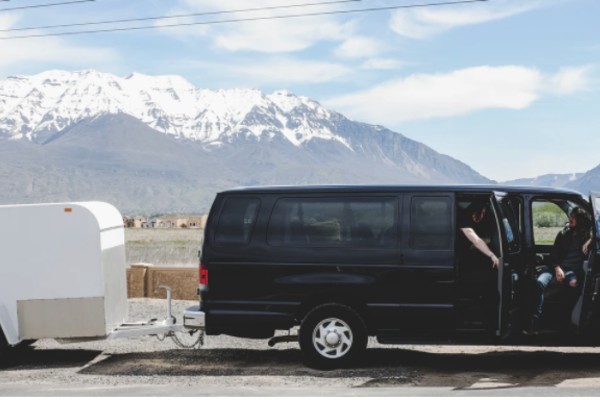 Towing an RV may sound like an easy endeavor, but a lot of people usually mess it up.
Towing an RV may sound like an easy endeavor, but a lot of people usually mess it up.
Not only can it inconvenience your outdoor trip, but it can also lead to expensive and possibly dangerous accidents.
Below are eight tips on how to safely and properly tow a recreational vehicle:
1. Know The Towing Capacity
The towing capacity basically refers to the weight your vehicle can tow. Assuming your monster truck can tow just about any trailer simply because it looks massive is a big mistake. You must get accurate figures.
Do your research and identify the towing capacity of your vehicle before buying or hitching any trailer. This figure is usually included in the owner’s manual and on the driver’s side door frame.
You should know that towing capacity can be affected by certain car options, so don’t look at the general towing capacity alone. Inspect the capacity for your specific towing vehicle.
2. Pack The RV Properly
How you pack your trailer will directly determine its stability. Put too many heavy items on one side, and you will notice the imbalance of your trailer as you drive along. This can make cornering harder and more dangerous.
Pack your trailer carefully to ensure there is equal weight distribution throughout. This includes at the front of the trailer near the hitch. Adding a bit more weight towards this area increases tongue weight. This gives you a steadier, more secured tow.
3. Know-How To Hitch And Unhitch The Trailer Correctly
You must learn how to hitch and unhitch your trailer correctly before driving off. This is very important because any mishap can lead to expensive damages and possibly severe injuries to yourself and other road users.
RVs come with different types of hitches. You’ll need to identify the specific hitch type on your trailer and then find a manual on how to use it. There are also plenty of resources online, including Youtube tutorials, that you could use.
Ideally, you should learn how to hitch and unhitch the trailer in a safe location like an empty parking lot. This gives you sufficient space to do your practice without worrying too much about damaging other people’s property.
4. Inspect Your Rig Before Driving Off
 Never drive off with your trailer without inspecting the entire rig beforehand. The consequences can be dire.
Never drive off with your trailer without inspecting the entire rig beforehand. The consequences can be dire.
Once you are done packing and hitching your RV, walk around the rig and ensure everything is fine. Most RVers actually have an inspection to-do list. This could include checking the hitch, tires, brakes, lights, mirrors, etc.
You can also do a quick visual inspection from a distance to see if your trailer is leaning on one side more than the other. This is particularly important if you’ve packed heavy items.
5. Learn Braking
Braking while towing a trailer is different than what you’re typically used to. For starters, the stopping distance is a bit longer due to the added weight. So always account for the extra distance in your calculation.
RVs also come with electric braking systems. You’ll need to learn how to set them up properly. The trailer should not rely too heavily on the tow vehicle’s brakes. Also, it shouldn’t pull at your vehicle.
These brake systems sound complicated, but they’re much easier to use once you understand them. Also, with the best brake controllers, getting the configuration right is usually fairly simple. Plus, there are various types of brake systems to choose from.
It’s always a good idea to test out your brakes every time you are starting a trip.
6. Check Visibility
Something else you should always check before driving off is visibility. This is essential for safety.
Make sure you can see the end of your trailer from both side mirrors. If your mirrors are too small, invest inside mirror extensions. A rearview camera is also a great investment.
7. Know Your Route
While towing your vehicle, the last thing you want is to find yourself in front of a low bridge that your trailer can not drive through. You’ll be forced to spend more time and fuel finding an alternative route. Worse still, you may not notice the bridge is too low until it’s too late and you’ve already damaged your RV.
Avoid such issues by investigating your route before embarking on the trip. Check whether there are any low clearance bridges, narrow lanes, and tight turns on the way.
You can buy a navigation system with RV settings to help you out with this.
8. Learn How To Park Properly
Backing an RV can be very challenging. It’s nowhere as intuitive as it is when parking your regular car. You’ll need to practice quite a lot before you get good at it.
Start practicing in an empty parking lot, then move to a trafficked lot as your confidence grows.
Hopefully, this guide has given you all the tips you need on how to hitch, tow, and park your RV safely. The most important thing is practicing. So find a nice low-traffic area to practice your hitching, turning, braking, and parking.
Become a Harlem Insider!
By submitting this form, you are consenting to receive marketing emails from: Harlem World Magazine, 2521 1/2 west 42nd street, Los Angeles, CA, 90008, https://www.harlemworldmagazine.com. You can revoke your consent to receive emails at any time by using the SafeUnsubscribe® link, found at the bottom of every email. Emails are serviced by Constant Contact








